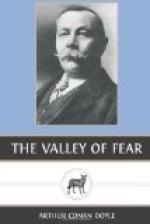“Then, with your permission, we will leave it at that, Mr. Mac. The temptation to form premature theories upon insufficient data is the bane of our profession. I can see only two things for certain at present — a great brain in London, and a dead man in Sussex. It’s the chain between that we are going to trace.”
Chapter 3 The Tragedy of Birlstone
Now for a moment I will ask leave to remove my own insignificant personality and to describe events which occurred before we arrived upon the scene by the light of knowledge which came to us afterwards. Only in this way can I make the reader appreciate the people concerned and the strange setting in which their fate was cast.
The village of Birlstone is a small and very ancient cluster of half-timbered cottages on the northern border of the county of Sussex. For centuries it had remained unchanged; but within the last few years its picturesque appearance and situation have attracted a number of well-to-do residents, whose villas peep out from the woods around. These woods are locally supposed to be the extreme fringe of the great Weald forest, which thins away until it reaches the northern chalk downs. A number of small shops have come into being to meet the wants of the increased population; so there seems some prospect that Birlstone may soon grow from an ancient village into a modern town. It is the centre for a considerable area of country, since Tunbridge Wells, the nearest place of importance, is ten or twelve miles to the eastward, over the borders of Kent.
About half a mile from the town, standing in an old park famous for its huge beech trees, is the ancient Manor House of Birlstone. Part of this venerable building dates back to the time of the first crusade, when Hugo de Capus built a fortalice in the centre of the estate, which had been granted to him by the Red King. This was destroyed by fire in 1543, and some of its smoke-blackened corner stones were used when, in Jacobean times, a brick country house rose upon the ruins of the feudal castle.
The Manor House, with its many gables and its small diamond-paned windows, was still much as the builder had left it in the early seventeenth century. Of the double moats which had guarded its more warlike predecessor, the outer had been allowed to dry up, and served the humble function of a kitchen garden. The inner one was still there, and lay forty feet in breadth, though now only a few feet in depth, round the whole house. A small stream fed it and continued beyond it, so that the sheet of water, though turbid, was never ditch-like or unhealthy. The ground floor windows were within a foot of the surface of the water.
The only approach to the house was over a drawbridge, the chains and windlass of which had long been rusted and broken. The latest tenants of the Manor House had, however, with characteristic energy, set this right, and the drawbridge was not only capable of being raised, but actually was raised every evening and lowered every morning. By thus renewing the custom of the old feudal days the Manor House was converted into an island during the night — a fact which had a very direct bearing upon the mystery which was soon to engage the attention of all England.




